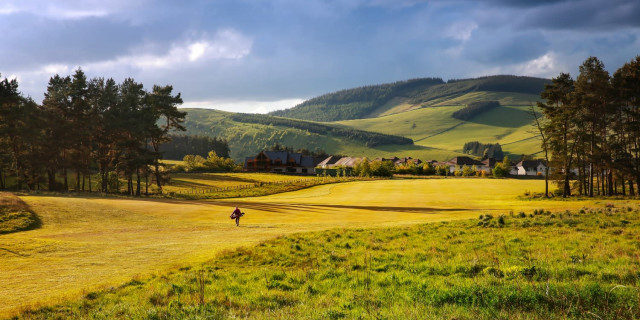Review of West Byfleet Golf Club
Guest post from Nick Bonfield, read Nick's blog online via The Golf Debate and follow Nick on Twitter via @thegolfdebate
 The Course
The Course
If you are looking for a scenic and pictorial golf course then you have come to the wrong place. West Byfleet Golf Club is not set against the backdrop of rolling hills, nor picturesque countryside. In fact, it is flanked on one side by houses and by a busy train track on the other, the heavy locomotive traffic a convenient excuse for bad play. In reality, however, West Byfleet is an extremely enjoyable test: play good golf and keep it straight and you might shoot the round of your life; take it for granted and play average golf and you will struggle to get anywhere near the thirty point mark.
The quality needed to succeed here is precision. At 6,197 yards, it is one of the shorter golf courses around. If you find the fairway off the tee, you will score well, but there are some tricky approaches to be found, thick rough, overhanging trees and 91 bunkers ready to gobble up wayward tee shots and approaches. The course was laid down in 1904 by Cuthbert Buchart and slightly modified in 1922 when it officially became West Byfleet Golf Club.
As well as an 18-hole course, West Byfleet Golf Club has a driving range, a chipping and putting green, practice nets and an area to practice wedge play.
My Experience
If you are going to have a good round, you need to score well on a front nine that is far easier than the back side. The first hole, a 403 yard par-4, often plays into the wind, and can provide for an inauspicious start. Find the fairway, however, and you should take no more than five.
The second is a good chance for birdie, the third a downhill right-to-left dogleg par-4 and possibly the hardest hole on the front nine. Hit it short and left and you are in trees, leak it out to the right and you face an approach of around 200 yards with trees on both sides of an extremely narrow fairway.
The fourth to the ninth is where you should be looking to make your score. Four is a simple par-3, and the fifth is less than 300 yards, but it is all about position. You have to hit the left side of the fairway off the tee or you will be blocked off by tall trees. Miss the fairway right and you will struggle for bogey.
The par-4 sixth is another example of the need for precision and accuracy. As on the fifth, if you find the wrong side of the fairway, you will be blocked out. A good drive down the left leaves an uphill approach to a wide green, with a slope at the front ready to catch any ball that is hit slightly fat.
The seventh is a narrow but relatively straightforward hole, and the first of the par 5’s. If you find the fairway, the green is just about reachable. A row of bunkers protect the lay-up area, so be prepared to play a lengthy third if you don’t want to take on the green.
Holes eight and nine are short, straight par 4s, at 280 and 320 yards respectively. You can drive the eighth in summer, but the sensible play is a mid to long iron for position, leaving a wedge approach and a good chance for birdie.
The tenth comes as a stark surprise after playing the two easiest holes on the course. It is a 445 yard 4, playing uphill and into the wind. Granted, the fairway is wide, but fairway bunkers lurk, and only the longest of hitters will be able to reach the green in regulation.
Eleven and twelve can cause difficulty before the signature hole: thirteen. It is a short, downhill par-3 with an enormous lake in front of the green ready to catch any poor tee shots. Two bunkers guard a very narrow entrance to a green that slopes steeply from back to front. A two putt is by no means guaranteed.
Fourteen is a shortish par four requiring a fade from the tee, but fifteen and sixteen are tough par 4s. On fifteen, anything left will find sand or gorse, and anything right will end up stuck behind an enormous tree. The green is undulating and has many different tiers. Find the wrong one, and you will do extremely well to two putt.
Sixteen, at 426 yards and uphill, is a challenge, especially given the large tree 100 yards from the tee ready to collect any drive with a low trajectory. Three bunkers on the right hand side of the fairway often catch drives that appear perfect from the tee. Find the fairway, and a long iron approach is needed to a green where only the top half of the flag is visible.
Seventeen is a mid-range par 3 with a narrow green protected on all sides by bunkers, which is followed by a frankly uninspiring yet straightforward final hole. It is the second par-5 on the course, and is reachable in two with a long drive. The fairway is generous, but, in a parallel to the seventh, two fairway bunkers render a lay-up almost redundant. The green is multi tiered, and can present difficulty when the pin is all the way at the back of the green.
Ask the Pro
I asked PGA Professional Daniel Painter to answer a few questions:
Q: Three qualities needed to succeed?
A: “good driver, straight hitter, good short game”
Q: Toughest hole?
A: “10th – It is 450 yards uphill with bunkers protecting the fairway and green”
Q: Favourite hole?
A: “The 5th – A short hole, but you need a well positioned tee shot to get a look at the green”
Q: Best round at West Byfleet?
A: “67”
Q: If you could play any course, what would it be?
A: “Augusta – looks unreal on the TV!”
Ranking
I would give West Byfleet Golf Club an overall ranking of 3.5/5
Related Content:
What do you think? post your thoughts and feedback on the Golfshake Forum: https://forum.golfshake.com/

 The Course
The Course















